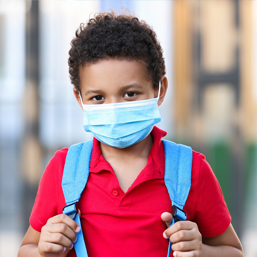
The removal of the mask mandate has brought joy to some, and apprehension to others.
Although not having to deal with the hassle of a mask everywhere you go is convenient, it was easier to explain the concept to children when the government required us to wear them.
Whether or not children wear a face covering is now solely in the hands of the parents and it can be difficult to explain to your child why they are still masking up when others are not (or vice versa.)
Talk about why
The first step to getting your children on board with the decision you choose is as simple as sharing your reasoning with them and honestly answering any questions they have.
For younger children, you may just have to let them know that, although it is no longer a rule that everyone has to follow, you want to keep them safe from germs and this is the best way to do so. A longer, more involved explanation may be necessary for an older child or teen. Don’t forget to let them voice their thoughts as they may have something valuable to contribute to the conversation.
Talk about what to do
One of the biggest concerns for children is that they will get made fun of if they do something different than their peers. It can help to talk them through different scenarios that could come up. It is a good idea to role play what they should say if someone teases them about wearing a mask.
Let them know what you would like them to do if this happens.
Should they go tell an adult?
Walk away?
Explain their choice?
Knowing what is expected of them can reduce anxiety and boost their confidence.
Talk about different situations
If your decision to wear a mask is based on the situation you are in, tell your child that ahead of time. Simply let them know that if there are few people in the space you are in, it’s okay not to wear a mask, but if it gets too crowded for your comfort, you will ask them to put their mask on.
Talk about acceptance
Possibly the most important thing to discuss is the acceptance of other families’ choices.
Explain that if there is another person wearing a mask in a situation where you have chosen not to, that is okay. It is up to their family to choose when they are comfortable, and there are a number of reasons they may still need to be protected.
On the flip side, there is no need to call out and bring attention to those who are not wearing masks in a circumstance where your family has decided that masking is the safest choice.
Tell your child that although other people may have different opinions or values, there is no need to argue about them in public.
Let your child know if someone asks them about their choice, it is best to simply tell the person that it’s what their family has decided to do and move along.
Talk about others
It can help to tell them that you are asking them to continue to wear a mask to help protect others as well as themselves.
Let them know that some children at the library story time could be immune-compromised, or live with their elderly grandparents, so you are continuing to wear masks to protect them.
Many children connect with the concept of helping others more than protecting themselves.
Show, don’t tell
Although it is important to open up the dialogue about your family’s masking choices, perhaps the most impactful thing you can do is to model the behavior yourself. If you are asking your child to wear a mask in certain circumstances, you should do the same. Children will always be more likely to do what you do, not what you say. Sometimes all it takes is the willingness to lead by example.
Calgary’s Child Magazine © 2024 Calgary’s Child